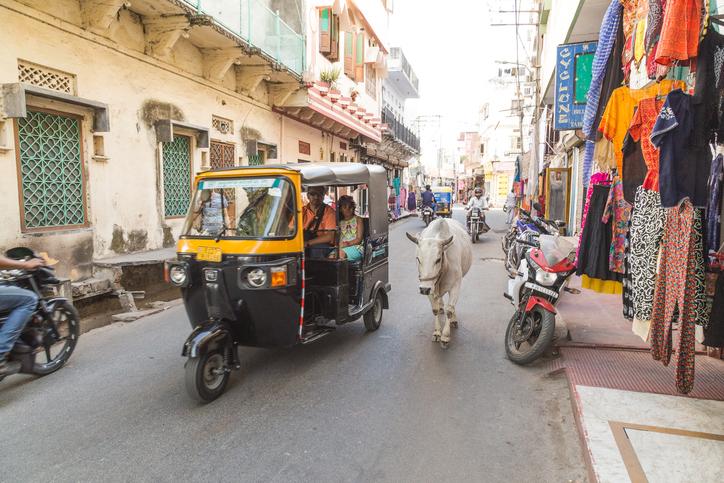Study abroad countries that you’ve never thought of
We’ve all considered studying abroad in the US or Australia, but have you ever thought about these alternative study abroad destinations?
- Study abroad
Share
When it comes to studying abroad, the world is truly your oyster. With international travel getting easier and universities developing exchange programmes all over the globe, you will be spoilt for choice when deciding where to study abroad.
Much has also been said of the benefits of spending even a small amount of time during your degree in a different environment. You will be exposed to new cultures, new languages, and you will have to learn to be resourceful, self-sufficient and independent. These are all qualities that future employers value, and can help set you apart from other students.
If you have ever thought about studying abroad, why not consider some of these countries that may not be on your radar right now? Explore these colourful, vibrant countries with blossoming higher education sectors and can provide a unique and fulfilling study abroad experience. And if these countries don’t take your fancy, many others could provide an enjoyable study abroad experience, so pull out a world map and start exploring.
1. Malaysia
While Malaysia is not often thought of as somewhere to study abroad, it turns out that it is actually one of the cheapest countries you can study in. With an affordable cost of living in the cities and lower tuition fees (around £3,000), it could be a destination to consider if you are looking to keep costs down.
The higher education on offer in Malaysia is some of the best in the continent, with the leading university, the University of Malaya in the top 350 universities in the world. Malaysia has long seen the benefit of welcoming international students, through the channel of branch campuses or student exchange programmes with a number of Western universities.
A number of scholarships are also available for students who wish to study in Malaysia.
Malaysia is a truly diverse country, with the capital of Kuala Lumpur a cosmopolitan city with soaring skyscrapers, delicious food and bustling nightlife. Yet if you were to travel outside the major cities, you would find yourself among beautiful rainforests and beaches.

Women in STEM: the benefits of studying abroad in Malaysia
2. Nigeria
Africa has a strengthening higher education sector with many countries investing more and more resources and funding in their universities. Nigeria, in particular, has a strong higher education sector, a result of a government pledge to make education more accessible to all.
Nigeria has only three universities in the World University Rankings, but it has more than 130 institutions in total. Universities offer majors in every discipline, although it is well-known for its education in health and medicine.
All university programmes are taught in English, despite there being more than 500 languages spoken in the country.
Nigeria is a colourful country, with a lot to offer international students. It is a vibrant city full of bustling clubs blaring out music until the early hours of the morning. It is also a great hub for further travel around Africa.

3. South Korea
Known as one of the four “Asian Tiger” economies, this powerhouse nation has seen an exponential increase in the number of international students over the past 10 years.
And it’s not really hard to see why. The government has invested heavily in its higher education sector in a bid to build international ties through scholarship opportunities, streamlined visa applications and attractive employment opportunities.
More and more universities are producing English-language programmes and some universities from the US and UK have also opened branch campuses in South Korea. A bonus to studying in South Korea is that tuition fees are the same for domestic and international students, varying between course and institution, but in the region of £3,000-£5,000.
In between studying, there are many things for students to do, such as shopping, hiking, visiting temples, palaces and markets, hanging out on the beach, and of course sampling the local cuisine.

Best universities in South Korea
4. Brazil
Brazil has an impressive number of universities, many of which appear in the World University Rankings and dominate the Latin America University Rankings.
A key selling point of studying in Brazil is that public education is free up to postgraduate level. This means that most public institutions will only charge students a registration fee.
Before applying to a university in Brazil, students must prove that they are able to study in Portuguese and take the admission exams. Students will also need to obtain a visa before heading to the country.
If you decide to study in Brazil, you’ll be making the choice to study in a lively, bustling country. Music is a huge part of Brazilian culture and you’ll never find yourself too far from a samba bar.

A week in the life of a student in Brazil
5. Ireland
Ireland is well-known for many things, including Guinness, pots of gold, and Irish dancing. But something that you might not have known is that it has a small but perfectly formed selection of universities. From the Hogwarts-esque Trinity College Dublin to the modern Royal College of Surgeons in Ireland (RCSI), there will be an institution to suit you.
Given that all courses are taught in English, EU and EEA students can study for free (international students from outside this area have to pay fees), and its proximity to the rest of Europe, Ireland is an attractive study abroad destination.
Ireland’s busy cities retain a small-town feel given the friendliness of the locals. Depending on your interests, you can spend your spare time hiking around the Emerald Isle, taking refuge in a pub to sample some Guinness, or strolling around the many museums and art galleries.

International perspective: a Canadian student in Ireland
6. India
India is a diverse country with a rich history embedded in everyday life.
Despite retaining much of its tradition, the country is also one of the biggest economies in the world, and higher education is a part of that. The recently launched Study in India programme aims to encourage more than 200,000 international students to come to India by 2023. It now also has one of the largest higher education systems in the world.
Many of the institutions in India focus on science and engineering programmes but arts and humanities programmes can be found in some of the general universities such as the Tezpur University.
Students can lead a relatively frugal lifestyle in India as the cost of living is much lower than in many other countries around the world.
And there will never be a shortage of places to explore in India, as it is packed with Unesco World Heritage sites, crowded markets and obviously, the best places in the world to get Indian food.

7. New Zealand
You've probably considered studying in Australia at some point but have you ever thought about its smaller neighbour? With its breathtaking scenery, friendly locals and bustling cities, New Zealand is becoming a popular study abroad destination for students from all over the world.
New Zealand has only eight universities but they all rank in the top 600 in the World University Rankings. Each university sets its own tuition fees, so course costs will vary depending on where you decide to study. Although tuition fees are on the pricier side for international students, the cost of living in the country is quite low.
On average, an international student can expect to pay NZ$20,000 (£10,499) for an arts and social sciences undergraduate degree, $25,000 (£13,124) for science and engineering and $75,000 (£39,372) for a dentistry and medicine degree.
And for a small nation, you’ll never run out of things to do in your leisure time. There are adventure sports for the daredevils, hiking trails for the nature lovers and heaps of restaurants for the foodies.

International perspective: a Chinese student in New Zealand
8. Taiwan
Another “Asian Tiger” country, Taiwan has set a target of 150,000 international students by 2020. This is being achieved by introducing more English-language programmes and scholarships for international students.
The top university in Taiwan, National Taiwan University, is in the top 200 of the World University Rankings and there are 32 Taiwanese universities in the World University Rankings in total.
Tuition fees in the country are pretty cheap, although they do vary across courses and institutions. Fees for international students are less than £1,000 per year at most universities, but you can expect to pay more at a private institution.
Like many Asian countries, Taiwan strikes a neat balance between the ancient and the contemporary. The majority of universities are located in the capital of Taipei, where tech companies sit next to temples and skyscrapers coexist with thriving markets.

Read more: How to choose where to study abroad